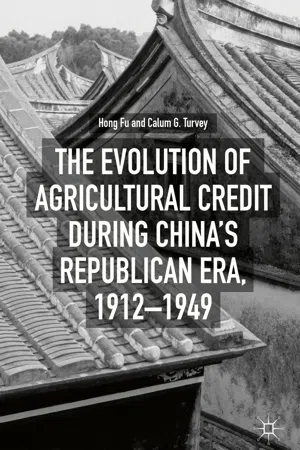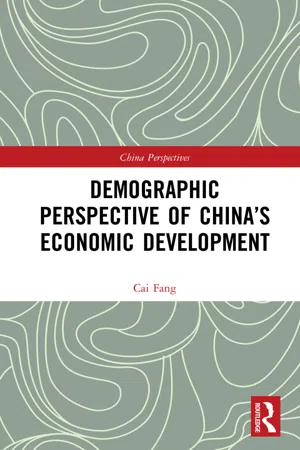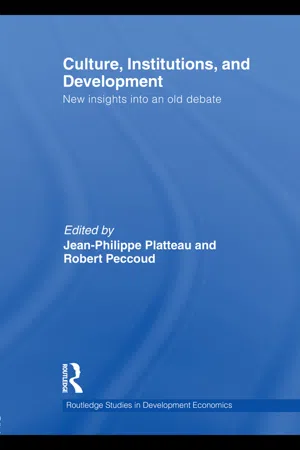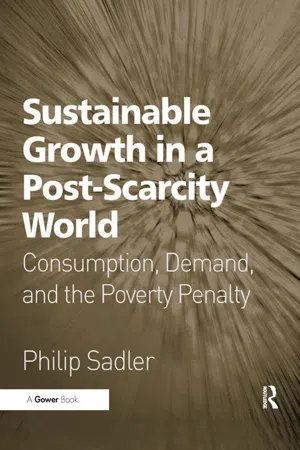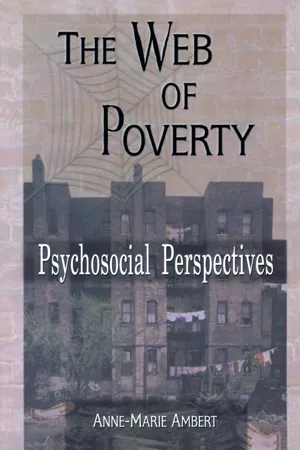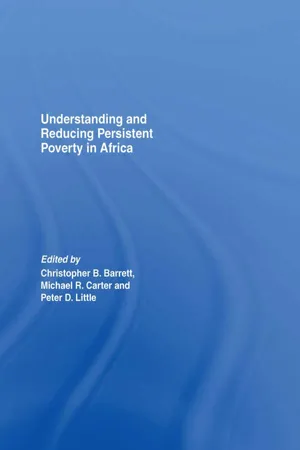Economics
Poverty Trap
The poverty trap refers to a situation where individuals or communities are unable to escape poverty due to various factors such as lack of access to education, healthcare, or economic opportunities. This can create a cycle of poverty that is difficult to break, as those affected may not have the resources or support to improve their circumstances, leading to a persistent state of deprivation.
Written by Perlego with AI-assistance
Related key terms
9 Key excerpts on "Poverty Trap"
- Hong Fu, Calum G. Turvey(Authors)
- 2018(Publication Date)
- Palgrave Macmillan(Publisher)
Poverty Trap deals not only with the magnitude of poverty (income below a threshold), or the frequency of poverty (measured by the percentage incidence in a population) but the nature and duration of poverty. The nature refers to the conditions that give rise to poverty, while the duration refers to length of time that one remains in poverty.As hinted above, the concept of equilibrium in a stochastic world is difficult to rationalize since nothing is ever stable. Instead, from any particular set of initial conditions the stochastic path sets a trajectory towards some distant locus to which it oscillates in some random fashion. This point in the future becomes more elusive as future time is extended, largely due to certain variance rules associated with non-stationary time paths. As this random path progresses towards a defined moment in time the variance is reduced in a linear or fractional way, until some point in time is observed and described by real data points. In the interim there are a multitude of paths, in fact an infinite number of paths upon which random and seemingly independent shocks can change economic trajectories in a permanent way. As we suggest in Chap. 2 , where China ended up in 1921 is not due to any single factor but the accumulation of seemingly random effects which accumulate in China’s history. Each event has the effect of shifting the population-land-economic dynamic in setting a new trajectory which may be exacerbated or reversed by subsequent random events. We are not alone in this view. For example, Perkins notes that if it were not for the Taiping rebellion in the middle of the nineteenth century that reduced the population by as many as 20 million, the rising population might have otherwise outstripped the ability of Chinese agriculture to produce adequate food supplies.40 While cause and effect might well explain the Taiping- eBook - ePub
Development and the State in the 21st Century
Tackling the Challenges facing the Developing World
- Erica Frantz, Natasha M. Ezrow, Andrea Kendall-Taylor(Authors)
- 2015(Publication Date)
- Bloomsbury Academic(Publisher)
Chapter 1 , it entails improving economic and social well-being of people, by developing human capital, infrastructure, environmental sustainability, social inclusion, health care, security, literacy and employment. According to Sen, economic growth is just ‘one aspect of the process of economic development’ (1983, 748).One of the problems with approaches that assume that economic growth will reduce poverty rates is that most of the very poor meet their needs through subsistent methods such as farming, hunting and bartering. Their standard of living may not go up just because the national income has increased. In many countries growth could take place, yet millions of people may still be stuck in ruts of poverty, or Poverty Traps. The next section explains in more detail what Poverty Traps are and why they persist.Poverty and development: Poverty TrapsFor many people in the developing world, poverty is a lifelong condition. With few opportunities and options, the impoverished get stuck in a Poverty Trap. The Poverty Trap refers to any self-reinforcing mechanisms that cause the poor to stay poor (Bloom et al., 2003, 355). Poverty Traps reinforce chronic poverty, which affects as many as 580 million people (Hulme, 2003, 411). Chronic poverty is conceptualized as poverty that is transmitted from one generation to the next. Children of impoverished households are more likely to remain in poverty. With chronic poverty ‘an individual experiences significant capability deprivations for a period of five years or more’ (Hulme, 2003, 405). In other words, they are chronically poor if they are living under the poverty line for more than five years. The poverty line is the minimum asset threshold below which families are not able to educate their children, and build up their productive assets (Carter et al., 2007,836). For those living in abject poverty, measured as less than $1.25 a day by the monetary approach, poverty is almost always enduring. The next sections explain why Poverty Traps endure. - Fang Cai(Author)
- 2020(Publication Date)
- Routledge(Publisher)
Meanwhile, many researchers disagree on the use of the concept of the middle-income trap. Although systematic research is not yet available, in what follows, we touch on the nature of such disagreements. First, some researchers hold that the word “trap” is improper, because it suggests “conspiracy”. How can an economy be framed? Second, some economists think that unlike the theory of the Poverty Trap or vicious circle of poverty, there is no economic theory available that can explain the many phenomena related to the so-called middle-income trap. Third, some suppose that the middle-income-trap theory lacks empirical evidence. It is also pointed out that over the past forty years, growth performance of middle-income countries has not been significantly lower than that of high-income and low-income countries. Last but not least, some researchers doubt the issue’s relevance to China: does the concept of the middle-income trap correctly depict China’s challenges and will it help China find the right solutions?A concept or proposition is worth bringing forward so long as it can be analyzed through theoretical frameworks, and has significant empirical evidence and specific relevance, so that more thorough discussion and studies can be carried out. For that reason, this article supports the concept of the middle-income trap and holds that relevant studies should be deepened. This article starts, in Section 5.2 , with a review of economic theories, of economic growth theories in particular, and demonstrates that the middle-income trap can certainly be included in existing economic growth analysis frameworks or has the potential of forming a special framework of its own. Section 5.3 introduces some empirical studies and statistical proofs of the middle-income trap and summarizes relevant characteristics of the concept. Finally, by introducing characteristics of China’s economic development phase, Section 5.4 discusses the implications of the concept of middle-income trap for China’s sustainable economic growth.5.2 Theoretical basis of middle-income trap
Traditionally, the word “trap” is used to describe an economic state of super-stable equilibrium that is beyond a comparative static equilibrium and cannot be changed by normal short-term outside forces. In other words, after the effect of a factor that helps improve per capita income is fully brought out, because it is somewhat unsustainable, other restraining factors will begin to work and offset that effect, bringing per capita income back to the original level. For example, the pessimistic views of Thomas Robert Malthus on the relationship between population growth and economic development are reflected in the “Malthusian trap” or the “Malthusian equilibrium”. R. R. Nelson went further to combine the Malthusian model with the Harrod–Domar growth model to form a development theory which is called the low-level equilibrium trap, used as a label for the less-developed countries (Hayami and Gōdo, 2009). Moreover, not only is absolute poverty an equilibrium state; some economic historians have put forward the hypothesis of “high-level equilibrium trap” as they try to explain China’s historical development and fix the Needham Puzzle. Therefore, the use of the term “equilibrium trap” has a long history in development economics.- eBook - ePub
Angles Of Vision
How To Understand Social Problems
- Leonard Beeghley(Author)
- 2018(Publication Date)
- Routledge(Publisher)
The vignette highlights the fact that the rewards of hard work tend to go to people who are born with some advantages. It also suggests how the social structure sets the range of opportunities for individuals: As social class declines, so do the number of choices people have and their effectiveness. Hence, no amount of effort will change the fact that most individuals will not cross class boundaries. This reality exists independently of them, limiting their choices. In practice, then, most people who work hard will never be poor. Others, including many who work just as hard and have just as much ability, will become impoverished at some point in their lives. In turn, a small proportion of the poor become trapped.But before pursuing that topic, I wish to pause for a moment. The tendency for the class structure to reproduce itself occurs in all societies, regardless of economic development. In industrial societies, however, this tendency can be regulated by public policies. The following variables suggest how the policy choices made in this country affect the poverty rate.The Vicious Circle of Poverty.
Most poverty, as noted previously does not last long. But temporary impoverishment occasionally combines with other difficulties, in a vicious circle, to snare people into long-term poverty.One way people become trapped is that their efforts at escape are thwarted and they become so discouraged they give up. Consider the Hilliards, and remember they represent lots of families. For many years Cedar Key has been a rural backwater. A nice place to live. Not much crime (okay, a few locals run drugs up and down the coast). But few (legal) jobs. In recent years, however, it has become a bit of an artist colony and tourist haven. So James decided to set up a kiosk next to the town dock and sell locally made "art" (junk, but the tourists don't know that). The result was transformative. He started shaving and stopped drinking. He was bringing in an income. But the number of street vendors is limited by law, and after the chamber of commerce protested to the police, James was forced to close his kiosk. So James cleaned up his car and started using it as a jitney, taking tourists from condominiums to the dock area at $1 per person. But after protests by the local cab company, he was again forced to stop. James knows the "American rule": You are supposed to keep trying, find work, and succeed over time. But this effort becomes harder after you are repeatedly thwarted. - eBook - ePub
Culture, Institutions, and Development
New Insights Into an Old Debate
- Jean-Philippe Platteau, Robert Peccoud(Authors)
- 2010(Publication Date)
- Routledge(Publisher)
So far the argument has been negative, that the culture of poverty view is inadequate as an account of the role of culture for the poor, let alone as a causal theory of poverty. In this section we turn to a more constructive approach, describing how cultural factors can play a significant role in the creation and persistence of poverty. This builds on the view that culture is essentially relational, and argues that we need to focus on the persistent effects of social and economic inequality, with effects on the poor reflective of overall relationships between groups.An intuitive definition is provided by Rao:Inequality traps … describe situations where the entire distribution is stable because the various dimensions of inequality (in wealth, power, and social status) interact to protect the rich from downward mobility, and to prevent the poor from being upwardly mobile.(Rao 2006: 11)The argument involves two moves. First, we argue that the concept of an ‘inequality trap’ is a useful way of looking at the condition of many societies, that is analytically distinct from a Poverty Trap. A society can get stuck in a position of a high level of inequality, with cultural factors playing a role in the manifestation and persistence of inequalities (interacting with economic and political structures). A formal account is given in the Appendix. Second, we outline the different ways in which cultural factors can lead to a high-inequality equilibrium. These have been approached in quite different ways, depending on whether the underlying source of a high inequality trap flows from issues around information, or more directly from group-based differences in power, status and stigma.The precise definition of an inequality trap formalized in the Appendix confines this concept to a long-run equilibrium, in which one group enjoys a distribution of advantages that are permanently superior to another group. Advantage is used broadly to refer to positions of value in a society, and can include dignity and social status, political influence, as well as health status, income and monetary wealth. While this chapter is focusing on implications for the bottom of the distribution, exemplified by dalit and adivasi groups, this can apply to different parts of the distribution. There is often keen interest in which group is on top: for example, the traditional dominance of Brahmins relative to middle groups was an issue of major social and political mobilization in Tamil Nadu and other parts of southern India.12 - eBook - ePub
Sustainable Growth in a Post-Scarcity World
Consumption, Demand, and the Poverty Penalty
- Philip Sadler(Author)
- 2016(Publication Date)
- Routledge(Publisher)
In Collier’s opinion, the problems these countries have are very different from those addressed for the past four decades in developing countries generally. Aid in its traditional form does not work well in these environments. Change in the societies at the very bottom must come from within. In all these countries, there are struggles between those trying to achieve change and entrenched interests opposing it. Much can be done to strengthen the hand of the reformers. But to do so will involve drawing upon a wide range of approaches.Collier lists a number of factors which, taken together, lead to persistent extreme poverty.The Conflict Trap
Some of the bottom billion countries are stuck in a pattern of violence, either a prolonged, civil war or a series of coups d’état. Countries with a high level of dependence on exports of valuable resources such as oil or diamonds are particularly likely to be conflict-ridden. Natural resources help both to finance conflict and to motivate it.The Natural Resource Trap
It might be assumed that the discovery of natural resource wealth would be a catalyst for prosperity, but this is only exceptionally the case. The ‘resource curse’ causes countries to suffer from the ‘Dutch disease’ (so-called because of the effects of North Sea gas on the Dutch economy), whereby resource exports cause the country’s currency to rise in value against other currencies, thus making the country’s other export activities uncompetitive.The Landlocked Trap
Landlocked countries incur much higher costs to import or export goods. Costs vary in ways that don’t depend on distance. The transport costs for a landlocked country depend on how much its coastal neighbour has spent on transport infrastructure. Landlocked countries also depend on their neighbours for markets; if neighbours are economically stagnant or embroiled in civil war that will obviously affect trade.The Trap of Poor Governance
Poor governance and policies can destroy an economy with alarming speed (Zimbabwe provides an obvious example). The leaders of some of the poorest countries are among some of the global superrich. Many of the politicians and senior public officials in the bottom billion are corrupt. - eBook - ePub
- Ann-Mari Sätre(Author)
- 2019(Publication Date)
- Routledge(Publisher)
This chapter paid attention to existing attitudes, what strategies active people have and what are the links between them. Do people want to hide, do they protest or do they try to change their own behaviour? People have expressed the view that both society and the individual are to blame for poverty. If you blame individuals, it is usually connected with the idea of people being passive, not trying to do anything to change their life. To answer the question whether they are able to get out of poverty or not, we have looked into what kind of actions they have chosen: are they coping to survive or using strategies to actually change their situation? What have they done concretely? The data highlights that. I also show the process explaining why people are not able to get out of poverty no matter how active they are. The importance of resources and agency is clear, it is both about what resources they have and their ability to use them, to transform them.A large portion of Russian families is close to the edge of poverty; younger families and families with many children are closer than others. There is a large share of wage earners whose wages are below subsistence level, providing a significant indicator of hardship. The situation some people end up with is chronic poverty where expenses are constantly higher than income. In order to handle the gap people have used whatever resources they have, which means that some of them have exhausted their resources. Losses of wealth among the poorest is a tendency which means that quite a few are losing a buffer they have had for possible future difficulties.What is left is your own labour power, and a tendency to work more and more in order to cope with a difficult situation. What is even more worrisome is that reaching this point makes people highly vulnerable. If something happens, it might easily start a downward fall.To conclude, even if society is to blame, this does not mean that individuals cannot do anything to change their situation. But they need some resources.Notes
1 The continued dependency on natural resources was reflected in employment patterns as well as in relative wages in the 1990s (Sätre 2001). In the first decade of the new century, average wages continued to be highest in the gas industry and oil extraction, and lowest in agriculture and the consumer industry (Rossiya v tsifrakh - eBook - ePub
The Web of Poverty
Psychosocial Perspectives
- Terry S Trepper, Anne Marie Ambert(Authors)
- 2014(Publication Date)
- Routledge(Publisher)
Unskilled immigrants, whether from one region to another or from another country, can no longer expect to secure the types of readily available and well-remunerated jobs that existed during earlier waves of immigration (Lieberson, 1980). It has been suggested that governments may have to be more selective in terms of immigration policy (Briggs, 1996). However, at least in Canada, the mere mention of selectivity gives rise to charges of racism and elitism. Moreover, porous borders and interminable coastlines make it difficult to curtail illegal immigration.ConclusionThe key causes of poverty are global and affect everyone in each of our societies; however, affluent as well as reasonably well-remunerated individuals are advantaged by these social factors. Indeed, the current structure and culture of the economy is sustained only because it strongly benefits approximately 25 percent of the population. Were it to threaten the welfare of professionals, executives, and well-paid employees, one would see an entirely different discourse emerge quite rapidly. But as long as only the poor and the economically marginal are devastated, the overall situation remains unchallenged. The disadvantaged do not have a voice, do not have power, and they vote less often than other citizens. In addition, they are not major shareholders of corporations, and their buying power is too minimal to affect governmental and corporate policies.Many current causes of poverty, such as the globalization of the economy, are perceived favorably or as inevitable by some economists, politicians, and corporation heads (Korten, 1995). The goal of international competitiveness becomes a major underlying factor in the discourse emphasizing personal causes of poverty, such as school dropout. Within this ideological context, school dropout is socially defined as detrimental because it threatens to reduce future competitiveness on the global market. But there are other reasons why it is detrimental—human reasons—which are not given preeminence. We can think here of the fact that a lack of education narrows life options for individuals in terms of health, employment, and family life; it also closes avenues of enjoyment by reducing options in the domain of leisure activities. These human consequences are in themselves powerful enough reasons to develop a system that encourages youth to remain in school longer and corporations to be more responsible to the needs of the citizens of their country. - Christopher B. Barrett, Peter Little, Michael Carter(Authors)
- 2013(Publication Date)
- Routledge(Publisher)
The Economics of Poverty Traps and Persistent Poverty: An Asset-Based Approach MICHAEL R. CARTER & CHRISTOPHER B. BARRETT *University of Wisconsin, Madison, USA, **Cornell University, Ithaca, NY, USAABSTRACTLongitudinal data on household living standards open the way to a deeper analysis of the nature and extent of poverty. While a number of studies have exploited this type of data to distinguish transitory from more chronic forms of income or expenditure poverty, this paper develops an asset-based approach to poverty analysis that makes it possible to distinguish deep-rooted, persistent structural poverty from poverty that passes naturally with time due to systemic growth processes. Drawing on the economic theory of Poverty Traps and bifurcated accumulation strategies, this paper briefly discusses some feasible estimation strategies for empirically identifying Poverty Traps and long-term, persistent structural poverty, as well as relevant extensions of the popular Foster-Greer-Thorbecke class of poverty measures. The paper closes with reflections on how asset-based poverty can be used to underwrite the design of persistent poverty reduction strategies.I. Persistent Poverty and the Challenge of Forward-looking Poverty Measurement
Much empirical poverty analysis of poverty is dedicated to defining, measuring or locating who is recently poor. Such analysis is almost unavoidably backward looking in the sense that it creates a portrait of who was poor at the time survey data were collected. However, the observation of persistent or chronic poverty motivates a more forward-looking question: Who will likely remain poor into the future?1The empirical papers that comprise this special issue contribute to answering this question by trying to understand the structural reasons that underlie poverty's persistence, asking when and why poverty reproduces itself over time, ‘laying eggs’ as one of the informants to the Chronic Poverty Report describes it (CPRC, 2004: 3). Some of the papers try to understand who among the poor is structurally positioned to take advantage of new economic opportunities when they appear (Adato et al., Barrett et al., Krishna et al., Peters and Whitehead).2
Learn about this page
Index pages curate the most relevant extracts from our library of academic textbooks. They’ve been created using an in-house natural language model (NLM), each adding context and meaning to key research topics.
